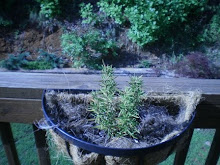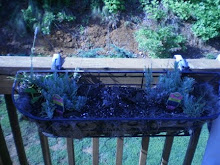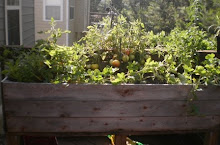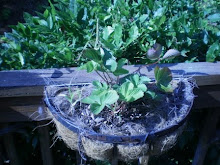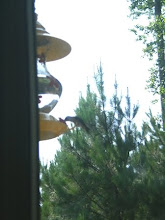Here is a list of “Edible Flowers/Plants” (make sure you
view photos of each plant so, if you decide to venture into the world of edible
flowers…..you are eating the right ones). It took some time, each one will
provide a link with a photo of the plant and some very interesting information. (just click name of flower/plant) Enjoy! Lou
As with anything, it primarily depends on your taste buds
which ones will be appealing to you!
Allium
All blossoms from the allium family (leeks, chives, garlic, garlic chives) are edible and flavorful! Flavors run the gamut from delicate leek to robust garlic. Every part of these plants is edible.
All blossoms from the allium family (leeks, chives, garlic, garlic chives) are edible and flavorful! Flavors run the gamut from delicate leek to robust garlic. Every part of these plants is edible.
Angelica
Depending on the variety, flowers range from pale lavender-blue to deep rose and have a licorice-like flavor.
Depending on the variety, flowers range from pale lavender-blue to deep rose and have a licorice-like flavor.
Anise Hyssop
Both the flowers and leaves have a subtle anise or licorice flavor.
Both the flowers and leaves have a subtle anise or licorice flavor.
Arugula
Blossoms are small with dark centers and with a peppery flavor much like the leaves. They range in color from white to yellow with dark purple streaks.
Blossoms are small with dark centers and with a peppery flavor much like the leaves. They range in color from white to yellow with dark purple streaks.
Bachelor’s Button
(when clicking on link scroll down to get
more info on Bachelor’s Button)
Grassy in flavor, the petals are edible but avoid the bitter calyx.
Grassy in flavor, the petals are edible but avoid the bitter calyx.
Basil
Blossoms come in a variety of colors, from white to pink to lavender; flavor is similar to the leaves, but milder.
Blossoms come in a variety of colors, from white to pink to lavender; flavor is similar to the leaves, but milder.
Bee Balm
The red flowers have a minty flavor.
The red flowers have a minty flavor.
Borage
Blossoms are a lovely blue hue and taste like cucumber!
Blossoms are a lovely blue hue and taste like cucumber!
Calendula / Marigold
A great flower for eating, calendula blossoms are peppery, tangy, and spicy–and their vibrant golden color adds dash to any dish.
A great flower for eating, calendula blossoms are peppery, tangy, and spicy–and their vibrant golden color adds dash to any dish.
Carnations / Dianthus
Petals are sweet, once trimmed away from the base. The blossoms taste like their sweet, perfumed aroma.
Petals are sweet, once trimmed away from the base. The blossoms taste like their sweet, perfumed aroma.
Chamomile
Small and daisy like, the flowers have a sweet flavor and are often used in tea. Ragweed sufferers may be allergic to chamomile.
Small and daisy like, the flowers have a sweet flavor and are often used in tea. Ragweed sufferers may be allergic to chamomile.
Provides delicate blossoms and flavor, which is anise-tinged, but
seems to be a hard plant to find.
Chicory
Mildly bitter earthiness of chicory is evident in the petals and buds, which can be pickled.
Mildly bitter earthiness of chicory is evident in the petals and buds, which can be pickled.
Chrysanthemum
A little bitter, mums come in a rainbow of colors and a range of flavors range from peppery to pungent. Use only the petals.
A little bitter, mums come in a rainbow of colors and a range of flavors range from peppery to pungent. Use only the petals.
I try to grow this every year in my garden…..seems to do
better in shaded areas. Like the leaves of the cilantro, people either
love the blossoms or hate them. The flowers share the grassy flavor of the herb.
Use them fresh as they lose their charm when heated.
Citrus (orange, lemon, lime, grapefruit, kumquat)
Citrus blossoms are sweet and highly-scented. Use frugally or they will over-perfume a dish.
Citrus blossoms are sweet and highly-scented. Use frugally or they will over-perfume a dish.
Clover
Flowers are sweet with a hint of licorice. Who knew!
Flowers are sweet with a hint of licorice. Who knew!
Dandelion
Read a whole post about dandelions here: Eating and Harvesting Dandelions.
Read a whole post about dandelions here: Eating and Harvesting Dandelions.
Dill
Yellow dill flowers taste much like the herb’s leaves.
Yellow dill flowers taste much like the herb’s leaves.
Fennel
Yellow fennel flowers are eye candy with a subtle licorice flavor, much like the herb itself.
Yellow fennel flowers are eye candy with a subtle licorice flavor, much like the herb itself.
Hibiscus
Mostly used inChina
Mostly used in
Impatiens
Flowers don’t have much flavor–best as a pretty garnish or for candying.
Flowers don’t have much flavor–best as a pretty garnish or for candying.
Jasmine
Super-fragrant blooms are used in tea; you can also use them in sweet dishes, but sparingly.
Super-fragrant blooms are used in tea; you can also use them in sweet dishes, but sparingly.
Johnny-Jump-Up
Adorable and delicious, the flowers have a subtle mint flavor great for salads, pastas, fruit dishes, and drinks. Candy them at Easter for colorful edible treats.
Adorable and delicious, the flowers have a subtle mint flavor great for salads, pastas, fruit dishes, and drinks. Candy them at Easter for colorful edible treats.
Lavender
Sweet, spicy, and perfumed, the flowers are a great addition to both savory and sweet dishes.
Sweet, spicy, and perfumed, the flowers are a great addition to both savory and sweet dishes.
Lemon Verbena
The diminutive off-white blossoms are redolent of lemon–and great for teas and desserts.
The diminutive off-white blossoms are redolent of lemon–and great for teas and desserts.
Lilac
The blooms are pungent, but the floral citrusy aroma translates to its flavor as well.
The blooms are pungent, but the floral citrusy aroma translates to its flavor as well.
Mint
The flowers are–surprise!–minty. Their intensity varies among varieties and when you run your hand across them, their scent is delightful.
The flowers are–surprise!–minty. Their intensity varies among varieties and when you run your hand across them, their scent is delightful.
Nasturtium
One of the most popular edible flowers, nasturtium blossoms are brilliantly colored with a sweet, floral flavor bursting with a spicy pepper finish. When the flowers go to seed, the seed pod is a marvel of sweet and spicy. You can stuff flowers, add leaves to salads, pickle buds like capers, and garnish to your heart’s content.
One of the most popular edible flowers, nasturtium blossoms are brilliantly colored with a sweet, floral flavor bursting with a spicy pepper finish. When the flowers go to seed, the seed pod is a marvel of sweet and spicy. You can stuff flowers, add leaves to salads, pickle buds like capers, and garnish to your heart’s content.
Oregano
Adds flavor and easy to grow. The flowers are a pretty, subtle version of the leaf many varieties.
Adds flavor and easy to grow. The flowers are a pretty, subtle version of the leaf many varieties.
Pansy
The petals are somewhat nondescript, but if you eat the whole flower you get more taste.
The petals are somewhat nondescript, but if you eat the whole flower you get more taste.
Rose
Remove the white, bitter base and the remaining petals have a strongly perfumed flavor perfect for floating in drinks or scattering across desserts, and for a variety of jams. All roses are edible, with flavor more pronounced in darker varieties.
Remove the white, bitter base and the remaining petals have a strongly perfumed flavor perfect for floating in drinks or scattering across desserts, and for a variety of jams. All roses are edible, with flavor more pronounced in darker varieties.
Rosemary
My favorite Herb ~ Flowers taste like a milder version of the herb; nice used as a garnish on dishes that incorporate rosemary.
My favorite Herb ~ Flowers taste like a milder version of the herb; nice used as a garnish on dishes that incorporate rosemary.
Sage
Blossoms have a subtle flavor similar to the leaves.
Blossoms have a subtle flavor similar to the leaves.
Squash & Pumpkin
Blossoms from both are wonderful vehicles for stuffing, each having a slight squash flavor. Remove stamens before using.
Blossoms from both are wonderful vehicles for stuffing, each having a slight squash flavor. Remove stamens before using.
Sunflower
Petals can be eaten, the bud steamed like an artichoke.
Petals can be eaten, the bud steamed like an artichoke.
Violets
One of the last…but, not the least of famous edible flowers, violets are floral, sweet, and beautiful as garnishes. Use the flowers in salads and to garnish desserts and drinks.
One of the last…but, not the least of famous edible flowers, violets are floral, sweet, and beautiful as garnishes. Use the flowers in salads and to garnish desserts and drinks.
Other great links for more:
http://www.phancypages.com/newsletter/Znewsletter2695.htm
(Worth Reading )
http://karenwillshaw.bizland.com/dory/Edible%20Plants%20and%20Herbs/album/slides/Mint.html
(worth viewing for visuals)












